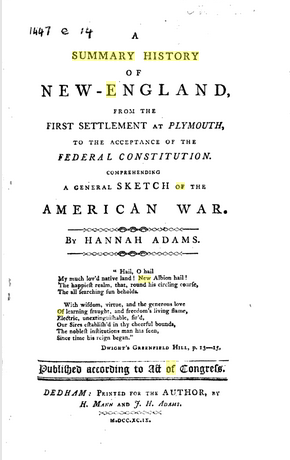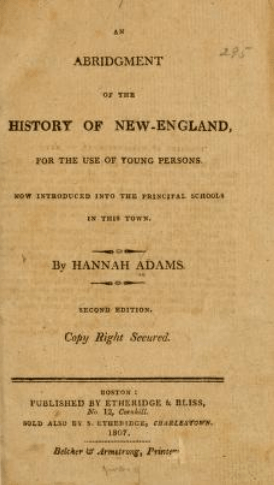A Summary History of New-England facts for kids

Frontispiece, first edition (1799)
|
|
| Author | Hannah Adams |
|---|---|
| Original title | A Summary History of New-England, from the first settlement at Plymouth, to the acceptance of the Federal Constitution. Comprehending a general sketch of the American War. |
| Country | United States |
| Language | English |
| Subject | history of the New England |
| Genre | history |
|
Publication date
|
1799 |
| Followed by | An abridgement of the history of New-England, for the use of young persons (1805) |
A Summary History of New-England is an important history book from the 1700s. It was written by an American author named Hannah Adams. The book focuses on the history of the New England region.
It was first published in 1799 in Dedham, Massachusetts. This book came out after her earlier work, A View of Religions, which was published in 1784. Hannah Adams didn't claim to be the first historian. Instead, she wisely used information from other writers. She included or shortened their accounts as needed.
In A Summary History of New-England, Adams told a more complete story than any before. It covered five of the oldest and most populated states in New England. The book explained their history leading up to the time when the federal government was formed. It was meant to be a summary, using information from many different sources. The goal was to give a clear and helpful overview without too many small details. When it was published, the Summary History was exactly what people needed.
Contents
How the Book Was Created
After Hannah Adams published the second edition of A View of Religions in 1791, she worked as a teacher. She lived with the families of her students. Soon, she felt inspired by her last book and decided to write another. She said it was "desperation, not vanity" that made her become a writer. She wanted to help young people who hadn't read much about their country's history.
At that time, there weren't many history books about New England. There was Magnalia Christi Americana by Cotton Mather and History of New England by Daniel Neal. If there had been a book covering history up to the U.S. Constitution, her job would have been easier.
Challenges in Writing
Hannah Adams had to spend a lot of time looking through old state papers, newspapers, and official records. Reading these old documents so much hurt her eyes. Because of this, her book was delayed for two or three years. It finally came out in 1799.
What the Book Covers
Hannah Adams used information from many famous writers about American history. She was praised for choosing good sources and using them well. People said she knew her subject very well and loved freedom. She also showed strong and fair judgment.
The history book was divided into forty chapters. It was a large book, about five hundred pages long. The book started with the story of Christopher Columbus discovering America. It then looked at the state of Great Britain after the Protestant Reformation. It also covered the unfair treatment of nonconformists under Queen Elizabeth and King James.
Key Historical Events
The book explained why John Robinson and his followers first went to Leiden. Then, it told how some of them later traveled to Plymouth. It described the people who settled Plymouth Colony. It talked about their difficulties, their government, their way of life, and their religion. The book also discussed their religious beliefs and their desire to be governed by biblical laws. A large part of the book, nearly half its pages, was a summary of the American Revolutionary War.
A Special Edition for Young Readers
In 1805, Hannah Adams published a shorter version of her book. It was called An abridgement of the history of New-England, for the use of young persons. This shorter book kept the most important parts of the original Summary History.
Changes for Younger Audiences
This new version had twenty chapters. It left out long discussions about religious arguments that might be hard for young people to read or understand. It also greatly shortened the story of the American Revolutionary War. Hannah Adams improved this version by using information from newer writers. She especially used John Marshall's book about George Washington. The paragraphs in this book were numbered, and its size was perfect for children. People said that Adams was very good at finding useful information and using it well.
A second edition of this shorter book came out in 1807. It was titled An Abridgment of the History of New England, for the use of young persons. Now introduced into the principal schools of this town.


